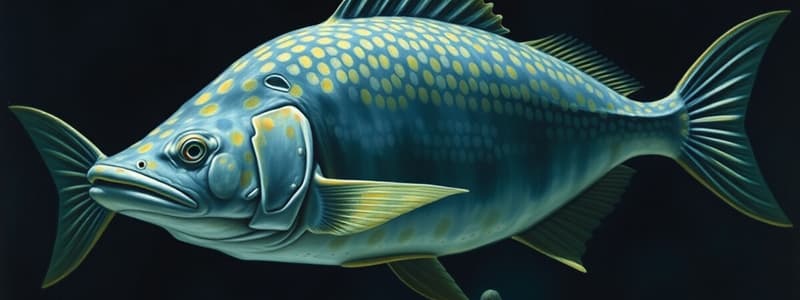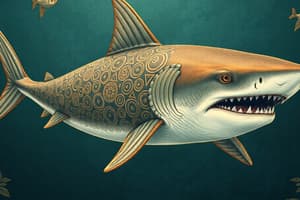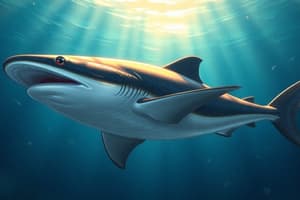Podcast
Questions and Answers
What does the term Chondrichthyes refer to?
What does the term Chondrichthyes refer to?
- Cartilaginous fish (correct)
- Mammals
- Bony fish
- Amphibians
What type of skeleton do Chondrichthyes have?
What type of skeleton do Chondrichthyes have?
Cartilaginous skeleton
Where are red blood cells produced in Chondrichthyes?
Where are red blood cells produced in Chondrichthyes?
Spleen
Chondrichthyes are ectothermic (cold-blooded).
Chondrichthyes are ectothermic (cold-blooded).
What adaptation do sharks have for buoyancy?
What adaptation do sharks have for buoyancy?
Sharks can only swim forward.
Sharks can only swim forward.
What is one physical characteristic of some Chondrichthyes?
What is one physical characteristic of some Chondrichthyes?
What is the lifespan of Chondrichthyes?
What is the lifespan of Chondrichthyes?
Chondrichthyes pups are born with a full set of teeth.
Chondrichthyes pups are born with a full set of teeth.
What may have led to the evolution of Chondrichthyes teeth?
What may have led to the evolution of Chondrichthyes teeth?
Chondrichthyes may have up to ___ teeth at one time.
Chondrichthyes may have up to ___ teeth at one time.
Most Chondrichthyes chew their food.
Most Chondrichthyes chew their food.
What is a characteristic of Chondrichthyes vision?
What is a characteristic of Chondrichthyes vision?
Nostrils in Chondrichthyes are used primarily for breathing.
Nostrils in Chondrichthyes are used primarily for breathing.
How do Chondrichthyes sense smell?
How do Chondrichthyes sense smell?
How do Chondrichthyes hear?
How do Chondrichthyes hear?
What are the Ampullae of Lorenzini used for?
What are the Ampullae of Lorenzini used for?
What is the function of the caudal (tail) fin in Chondrichthyes?
What is the function of the caudal (tail) fin in Chondrichthyes?
What is the role of the dorsal fin in Chondrichthyes?
What is the role of the dorsal fin in Chondrichthyes?
What do the pectoral fins in Chondrichthyes provide?
What do the pectoral fins in Chondrichthyes provide?
What do pelvic fins in Chondrichthyes provide?
What do pelvic fins in Chondrichthyes provide?
How do Chondrichthyes perform respiration?
How do Chondrichthyes perform respiration?
What advantage do sharks have in terms of immunity?
What advantage do sharks have in terms of immunity?
What is unique about the internal salt concentration of Chondrichthyes?
What is unique about the internal salt concentration of Chondrichthyes?
What role do rectal glands play in Chondrichthyes?
What role do rectal glands play in Chondrichthyes?
Chondrichthyes reproduce through external fertilization.
Chondrichthyes reproduce through external fertilization.
What are claspers?
What are claspers?
What does oviparity in Chondrichthyes mean?
What does oviparity in Chondrichthyes mean?
What characterizes ovoviviparity in Chondrichthyes?
What characterizes ovoviviparity in Chondrichthyes?
What is viviparity in Chondrichthyes?
What is viviparity in Chondrichthyes?
Flashcards are hidden until you start studying
Study Notes
Class: Chondrichthyes
- Known as "cartilaginous" fish, including sharks, rays, and skates.
- Have survived all five major mass extinction events in prehistoric history.
Physical Characteristics
- Possess a cartilaginous skeleton which is lighter and more flexible than bone.
- Red blood cells are produced in the spleen.
- Ectothermic, meaning they are cold-blooded.
- Sharks have an oily liver that aids in buoyancy.
- Limited to swimming forward; cannot swim backward.
- Some species have venomous spines, with poison glands along the spine grooves.
- Lifespan ranges from 20 to 30 years.
- Newly born pups have a full set of teeth.
Teeth
- Chondrichthyes may have up to 3,000 teeth at any given time, arranged in multiple rows.
- Possess as many as 5 rows of teeth simultaneously.
- Most species do not chew; they gulp food whole.
Acute Senses
- Sharp vision, although unable to differentiate colors.
- Nostrils serve primarily for smell rather than breathing.
- Have an exceptional sense of smell; water enters the nostrils, connecting to the olfactory bulb.
- Can hear by sensing vibrations through auditory organs in the inner ear.
- Ampullae of Lorenzini detect electrical fields, helping in navigation and locating prey.
Fins and Movement
- Caudal (tail) fin provides speed and acceleration.
- Dorsal fin serves as a stabilizer during swimming.
- Pectoral and pelvic fins assist in lift and maneuverability.
Respiration
- Sharks use spiracles to draw water over their gills, allowing them to breathe while resting on the sea floor.
Immunity
- Sharks exhibit heightened immunity levels against viral infections, with liver oil containing compounds similar to those found in human breast milk.
Osmoregulation
- Maintain an internal salt concentration lower than surrounding seawater.
- Do not drink seawater; instead, they retain urea to balance salt concentration.
- Rectal glands are responsible for excreting excess sodium chloride from the bloodstream.
Reproduction
- Internal fertilization is the primary reproductive method.
- Males possess claspers for sperm transfer.
- Oviparous species lay eggs on the ocean floor.
- Ovoviviparous species allow eggs to hatch internally; pups may consume unfertilized eggs or each other for nourishment.
- Viviparous sharks nourish developing young through a placenta and umbilical cord situated between the pectoral fins.
Studying That Suits You
Use AI to generate personalized quizzes and flashcards to suit your learning preferences.



